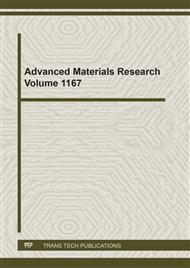[1]
M. Mangon, Production of the green matter of leaves under the influence of the electric light,, Lond. Edinb.Dublin Philos. Mag. J. Sci., vol. 22, pp.327-328, (1861).
DOI: 10.1080/14786446108643161
Google Scholar
[2]
F. Bantis, S. Smirnakou, T. Ouzounis, A. Koukounaras, N. Ntagkas and K. Radoglou, Current status and recent achievements in the field of horticulture with the use of light-emitting diodes (LEDs),, Sci. Hortic., vol. 235, pp.437-451, (2018).
DOI: 10.1016/j.scienta.2018.02.058
Google Scholar
[3]
Z. Wang, H. LIN, D. Zhang, Y. Shen, Y. Li, R. Hong, C. Tao, Z. Han and L. Chen, Deep-red emitting Mg2TiO4:Mn4+ phosphorceramics for plant lighting,, Research Square, pp.1-23, (2020).
DOI: 10.21203/rs.3.rs-30968/v1
Google Scholar
[4]
M. Kacira, Greenhouse Production in US: Status, challenges, and opportunities,, in In Proceedings of the CIGR Conference on Sustainable Bioproduction-Water, Energy, and Food, Tokyo, Japan, (2011).
Google Scholar
[5]
R. Wojciechowska, O. Długosz-Grochowska, A. Kołton and M. Żupnik, Effects of LED supplemental lighting on yield and some quality parameters of lamb's lettuce grown in two winter cycles,, Scientia Horticulturae, vol. 187, no. 187, pp.80-86, (2015).
DOI: 10.1016/j.scienta.2015.03.006
Google Scholar
[6]
R. Bula, R. C. Morrow, T. W. Tibbitts and D. J. Barta, Light-emitting diodes as a radiation source for plants,, HortScience, vol. 26, no. 2, pp.203-205, (1991).
DOI: 10.21273/hortsci.26.2.203
Google Scholar
[7]
H. Hye Kim, R. M. Wheeler, J. C. Sager, N. C. Yorio and G. D. Goins, Light-emitting diodes as an illumination source for plants,, in a review of research at Kennedy Space Center, Habitat (Elmsford), (2005).
DOI: 10.3727/154296605774791232
Google Scholar
[8]
G. D. Massa, H. Hye Kim, R. M. Wheeler and C. A. Mitchell, Plant productivity in response to LED lighting,, HortScience, vol. 43, pp.1951-1956, (2008).
DOI: 10.21273/hortsci.43.7.1951
Google Scholar
[9]
S. D. Gupta and B. Jatothu , Fundamentals and applications of light emitting-diodes (LEDs) in vitro plant growth and morphogenesis,, Plant Biotechnol Rep, vol. 7, pp.211-220, (2013).
DOI: 10.1007/s11816-013-0277-0
Google Scholar
[10]
A. Agarwal and S. D. Gupta, Impact of light emitting-diodes (LEDs) and its potential on plant growth and development in controlled-environment plant production system,, Curr Biotechnol, vol. 5, pp.28-43, (2016).
DOI: 10.2174/2211550104666151006001126
Google Scholar
[11]
M. Olle and A. Viršile, The effects of light-emitting diode lighting on greenhouse plant growth and quality,, Agric. Food Sci., vol. 22, pp.223-234, (2013).
DOI: 10.23986/afsci.7897
Google Scholar
[12]
X. Li, Z. Chen, B. Wang, R. Liang, . Y. Li, L. Kang and P. Liu, Effects of Impurity Doping on the Luminescence Performance of Mn4+-Doped Aluminates with the Magnetoplumbite-Type Structure for Plant Cultivation,, Materials, vol. 86, no. 12, pp.1-11, (2019).
DOI: 10.3390/ma12010086
Google Scholar
[13]
P. Smet, A. B. Parmentier and D. Poelman, Selecting conversion phosphors for white lightemitting diodes,, Journal of the Electrochemical Society, vol. 158, pp. R37-R54, (2011).
DOI: 10.1149/1.3568524
Google Scholar
[14]
E. F. Schubert, J. K. Kim, H. Luo and J.-. Q. Xi, Solid-state lighting-a benevolent technology,, Reports on Progress in Physics, vol. 69, pp.3069-3099, (2006).
DOI: 10.1088/0034-4885/69/12/r01
Google Scholar
[15]
W.-. N. W, J. A. Kaduk, S. H. Lapidus, L. Ribaud and S. P. Diwanji, Synchrotron X-ray diffraction study of double perovskites Sr2RNbO6 ( R = Sm, Gd, Dy, Ho, Y, Tm, and Lu),, Powder Diffraction, vol. 33, no. 4, pp.1-22, (2018).
DOI: 10.1017/s0885715618000593
Google Scholar
[16]
M. G. Brik, W. . W. Beers, W. Cohen, S. A. Payne, N. . J. Cherepy and A. M. Srivastava, On the Mn4+ R-line emission intensity and its tunability in solids,, Lawrence Livermore Laboratory, Livermore, CA, 94550, US, (2020).
DOI: 10.1016/j.optmat.2019.03.046
Google Scholar
[17]
X. Li, Z. Chen, B. Wang, R. Liang, Y. Li, L. Kang and P. Liu, Effects of Impurity Doping on the Luminescence Performance of Mn4+-Doped Aluminates with the Magnetoplumbite-Type Structure for Plant Cultivation,, materials, vol. 12, no. 86, pp.1-11, (2019).
DOI: 10.3390/ma12010086
Google Scholar
[18]
J. Du, O. Q. De Clercq, K. Korthout and D. Poelman, LaAlO3:Mn4+ as Near-Infrared Emitting Persistent Luminescence Phosphor for Medical Imaging: A Charge Compensation Study,, Materials, vol. 1422, no. 10, pp.1-14, (2017).
DOI: 10.3390/ma10121422
Google Scholar
[19]
Y. Tanabe and . S. Sugano, The absorption spectra of complex ions II,, J. Phys. Soc. Jpn, vol. 9, pp.766-779, (1954).
DOI: 10.1143/jpsj.9.766
Google Scholar
[20]
B. Henderson and G. F. Imbusch, Optical Spectroscopy of Inorganic Solids, Oxford Science Publicaiton, (1989), pp.1-672.
Google Scholar
[21]
I. Baginskiy, R. S. Liu, C. L. Wang, R. T. Lin and Y. J. Yao, Temperature Dependent Emission of Strontium-Barium Orthosilicate (Sr2-xBax)SiO4:Eu2+ Phosphors for High-Power White Light-Emitting Diodes,, Journal of The Electrochemical Society, vol. 158, no. 10, pp.118-121, (2011).
DOI: 10.1149/1.3625282
Google Scholar
[22]
J. S. Kim, Y. H. Park, S. M. Kim, J. C. Choi and H. L. Park, Temperature-dependent emission spectra of M2SiO4:Eu2+ (M=Ca, Sr, Ba) phosphors for green and greenish white LEDs,, Solid State Communications, vol. 133, no. 7, pp.445-448, (2005).
DOI: 10.1016/j.ssc.2004.12.002
Google Scholar


